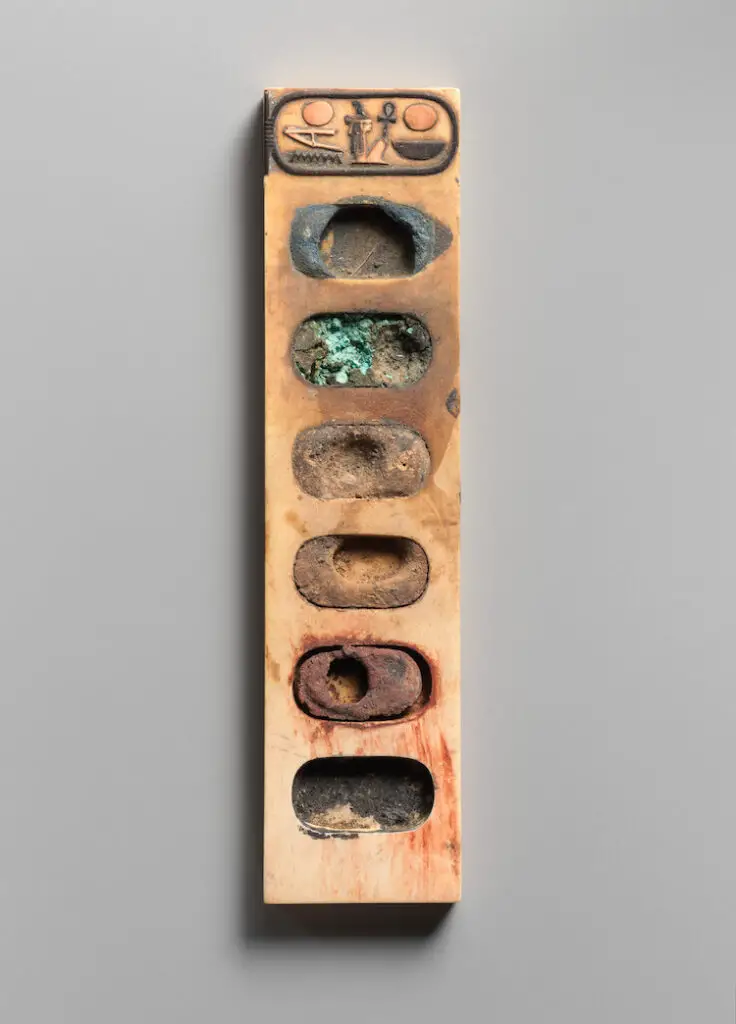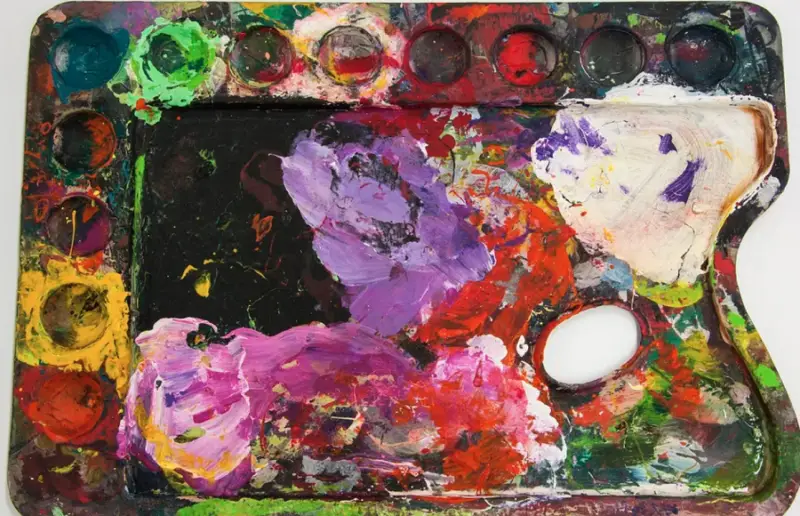A good quality oil paint is highly-pigmented and offers good coverage and opacity. Such oil paints are expensive, so you don’t want to waste them. If there is paint left on your palette at the end of a painting session, don’t panic.
Here are 7 tips on how to keep oil paint from drying on the palette:
- Place the palette in the freezer.
- Store the palette in an airtight container.
- Use clove oil or linseed oil.
- Keep your studio cool.
- Cover the palette with a metal lid.
- Use a slow-drying oil paint.
- Use the paint to make a neutral base.
Read further and learn how to keep oil paint wet on your palette, and how to store unused oil paint overnight with our article How Can I Keep Oil Paint From Drying on the Palette?
Table of Contents
Place the Palette in the Freezer
The best way to store unused oil paint is in a cool dark place (such as your freezer) to avoid the effects of light and heat on the oxidation process of the oil medium.
Don’t worry about the oil paint freezing over, as household freezers are usually set at -18°C (0°F). The paint won’t freeze because oil paints often use linseed oil as a medium, which freezes  at -20 °C (-4 °F).
at -20 °C (-4 °F).
When you’re ready to put your palette into the freezer, put it into an airtight container so the paint doesn’t get disturbed and you don’t transfer any paint onto food items. If you don’t have space in your freezer, storing the palette in the refrigerator will also work.

Store the Palette in an Airtight Container
A convenient way to prevent your oil paint from drying on the palette is to store it in an airtight container. The container should be large enough that the edges or lid don’t affect the paint blobs.
When an airtight container is sealed shut, it contains very little oxygen, which is the element responsible for drying oil paint. Since light also oxidizes oil paint, use an opaque container, and store it in a dark place.
To prevent heat oxidation, store the container in the coolest part of your studio, in your refrigerator, or freezer (if you have space).
If you don’t have an airtight container, you can cover the palette with plastic wrap or aluminum foil. Try to use this method as a last resort because the plastic wrap or foil sticks to the paint, which can cause wastage and make a mess.
Use Clove Oil or Linseed Oil
Clove and linseed oil cause oil paint to dry at a slower rate, and you might have a bottle of one of these oils in your studio. These oils act as an antioxidant and slow down the oil paint’s oxidation.
Here are some effective ways to use these oils if you want to keep your oil paint from drying on the palette:
- Add a drop of clove oil to each oil paint blob on your palette, and place it in a container or cover it with plastic wrap.
- Soak a cotton wool ball in clove or linseed oil, and place it in a container with your palette.
- Gently mist your palette with linseed oil, and store it in a container or cover it with plastic wrap.
If you’re using the fat over lean painting method (mixing the lower oil paint layers with solvent to keep them thinner and speed up drying), adding more oil can impact the effect you’re trying to create.
painting method (mixing the lower oil paint layers with solvent to keep them thinner and speed up drying), adding more oil can impact the effect you’re trying to create.
Keep Your Studio Cool
If you can’t store your palette in the freezer or refrigerator, and you don’t have access to an airtight container, keeping your studio cool can help slow down the oil paint drying rate.
Turn your studio’s air conditioning or thermostat as low as possible, and keep it at this temperature until you’re ready to use the paint again. This method uses a lot of power and can seem like a waste for only one palette of oil paint, so you’ll need to consider if it’s worth the spike in your energy bill.
Cover the Palette With a Metal Lid
As I’ve explained above, oil paint dries slower when it’s in a cool, dark, and low-oxygen environment. Placing a lid over your palette creates darkness over the paint, and as long as you store the covered palette in a cool place, this method will help prevent your oil paint from drying.
Here are some examples of lids you could use for your palette:
- Clean trash can lid for large palettes.
- Kitchen storage canister lid.
- Clean pasta sauce jar lid for small oil paint amounts.

Use a Slow-Drying Oil Paint
Oil paint does not dry by evaporation. Instead, the oil solidifies by oxidation. Different drying oils in the paint have different rates or speeds of oxidation.
The most common drying oils are:
- Linseed oil
- Walnut oil
- Poppy oil
- Safflower oil
Linseed oil dries the fastest while safflower oil oxidizes at the slowest rate. To keep your oil paint from drying on the palette, consider an oil paint with one of the slower-drying oils.
The individual brand formulation and the types of color pigments also affect the drying speed of oil paints. Titanium white oil paint generally dries the slowest, while burnt umber dries overnight.
Use the Paint To Make a Neutral Base
Instead of keeping the remaining paint on your palette and storing it carefully, you could always use it to make a neutral base for future paintings.
This is an excellent idea because colors on the palette can sometimes no longer be separated at the end of a painting session. If the paint is still wet and workable, you don’t have to throw any away.
Instead, mix all of the colors thoroughly. Use a brush or palette knife to make sure there are no individual streaks or ribbons of colors.
When you have a solid, uniform color, you can store it in a glass container with an air-tight lid in the freezer.

Final Words
When it comes to painting, sometimes you have to take a break for a few hours (or days) at a time. In this case, following the advice above to keep your oil paints from drying on the palette will save you from wasting your expensive oil paints.
Also just a quirky nerdy comment on artist’s palettes…
The Metropolitan Museum of Art in New York City added in 2021 a new Ancient Egyptian treasure to its collection: a 3,400-year-old painter’s palette carved from a single piece of ivory. And the little strip of untapped inspiration is so well preserved that it still has all its pigments caked into their wells.
to its collection: a 3,400-year-old painter’s palette carved from a single piece of ivory. And the little strip of untapped inspiration is so well preserved that it still has all its pigments caked into their wells.

Sources
- YouTube: Rae Whalen: Keeping Oil Paints From Drying Out On The Palette

- YouTube: Rae Whalen: Keeping Oil Paints From Drying Out On The Palette, Part II

- YouTube: Tanner Steed: How to Keep Your Oil Paint and Brushes From Drying Out

- YouTube: Doris Rose Art: OIL PAINT TUTORIAL || How to Stop Your Paint Drying on Your Palette

- YouTube: SIMPLIFY Drawing and Painting: Oil Painting Mediums – When, Why and How to Use Them
- YouTube Art Prof: Create & Critique: DIY Glass Palette for Painting: Make Your Own!

- King’s Framing & Art Gallery: Oil paints – Deep, Rich and Luxurious
- Jackson’s Art Supplies: Why is Oil Paint so Expensive?
- Chemistry StackExchange: How do cloves break down plastic?

- Scientific American: The Chemistry of Oil Painting



